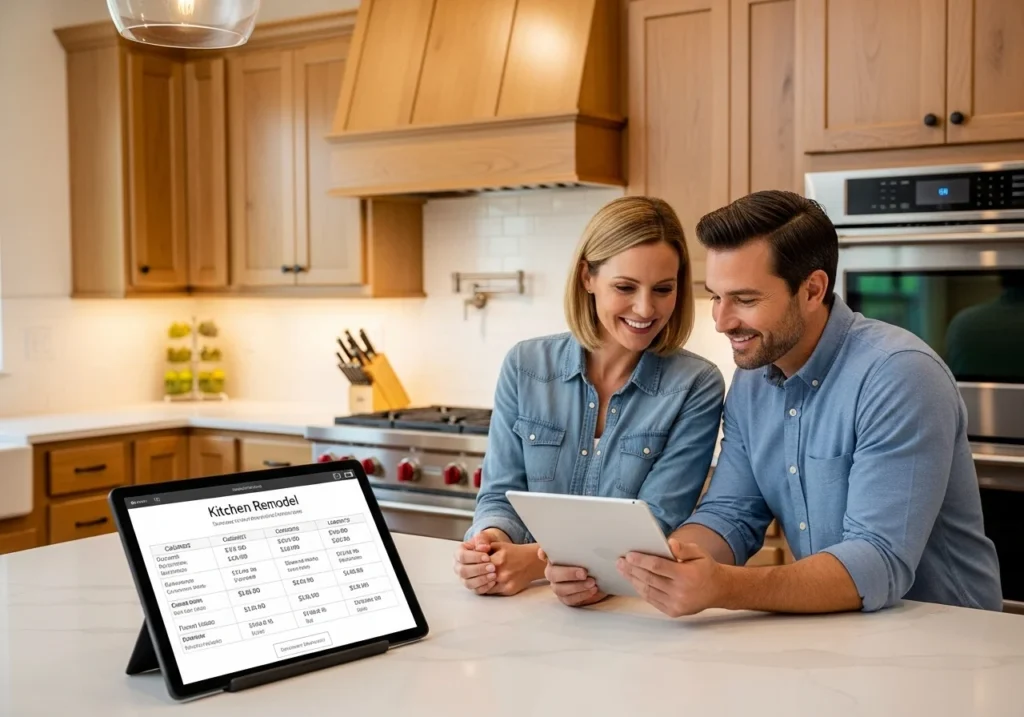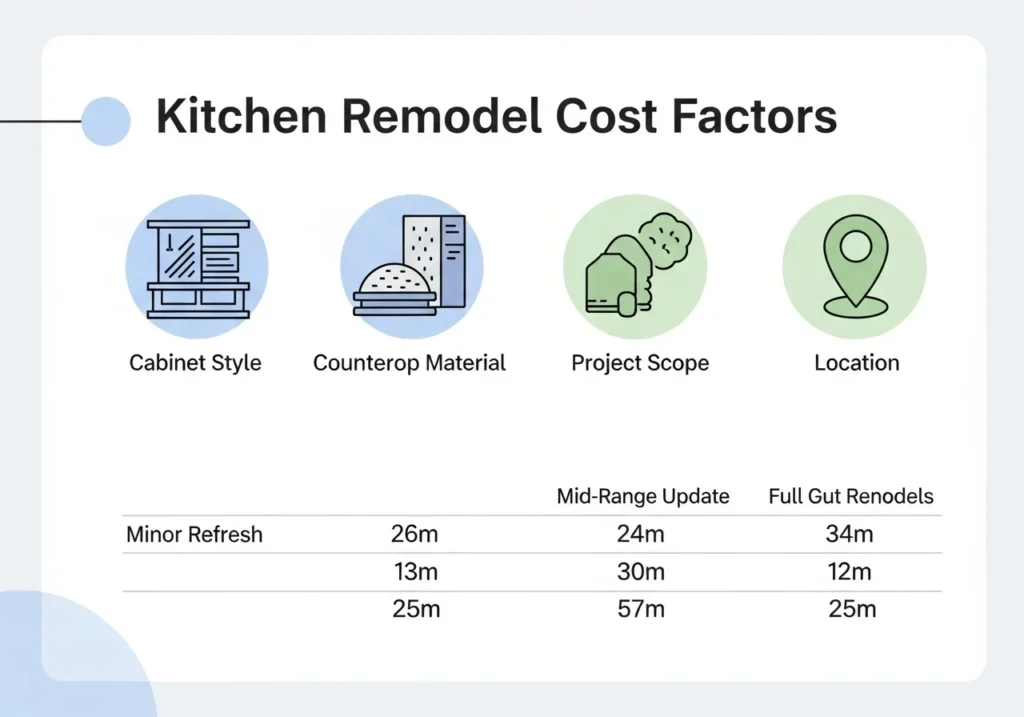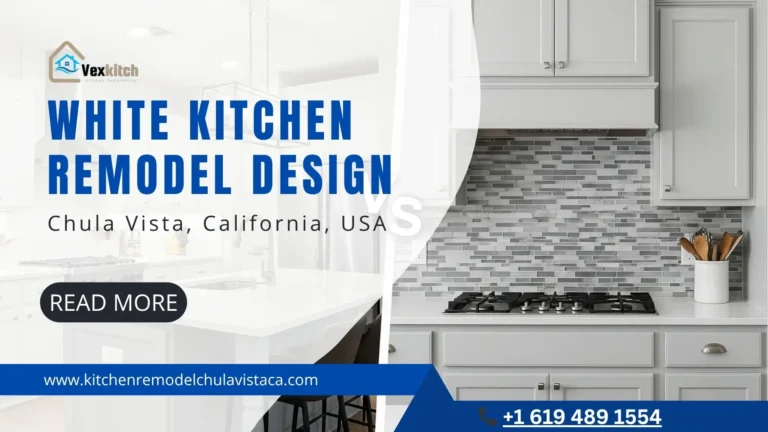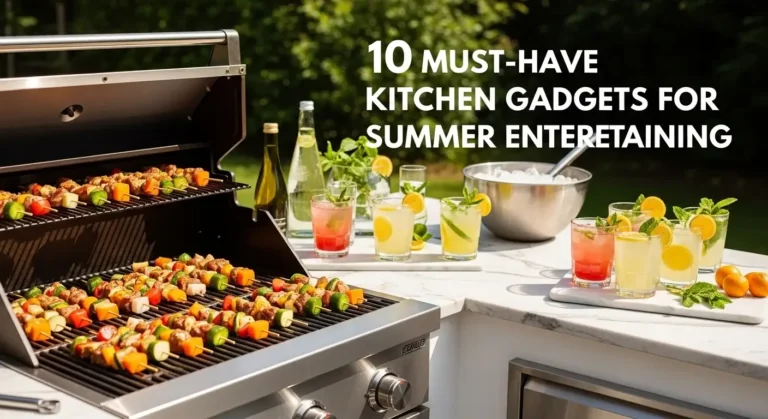Free Kitchen Remodeling Quotes
Getting a clear idea of how much your kitchen remodel will cost is often the first hurdle, and it can feel overwhelming. Without solid numbers, planning feels like guesswork, and budget surprises can throw everything off track.
Free kitchen remodeling quotes solve this by giving upfront estimates tailored to your specific needs, helping you make confident decisions without the guesswork.
This post will break down how to get accurate quotes, what factors influence pricing, and how to use these insights to plan your dream kitchen smartly.
Understanding kitchen remodeling basics is key before diving into quotes, so you know what’s realistic for your space. Later, we’ll explore custom cabinetry and countertops, a major cost driver in any project, and how to evaluate those options.
What you’ll learn:
- How free quotes simplify budgeting and save time
- Key elements that shape remodeling costs
- Tips to spot reliable contractors through quotes
- Smart ways to compare offers and avoid pitfalls
Free kitchen remodeling quotes provide an upfront estimate of labor, materials and associated fees without cost to you. They help homeowners:
- Gauge budget requirements
- Compare contractor offerings
- Identify potential cost drivers
Expect estimates to vary based on project scope, geographic location and material choices.


How to Obtain Free Quotes
1. Research and Shortlist Contractors
- Look for licensed, insured professionals in your area.
- Read reviews on multiple platforms (Google, Yelp).
- Aim for at least three different contractors to compare fairly.
2. Prepare Detailed Project Information
- Scope: Cabinets, countertops, flooring, appliances, etc.
- Measurements: Accurate room dimensions and layouts.
- Style Preferences: Modern, traditional, transitional.
- Materials: Wood species, stone types, hardware finishes.
Providing clear details minimizes surprises in final pricing.
3. Ask the Right Questions
- Does the quote include permits and inspections?
- Are demo and disposal costs itemized?
- What warranties apply to workmanship and materials?
- Which payment schedule is standard (deposit, progress payments, final)?
Comparing Quotes Effectively
When you have multiple quotes in hand, compare like‑for‑like items. A simple table can highlight differences:
| Remodel Scope | Average Cost Range (National) | Typical Timeline |
|---|---|---|
| Minor Refresh (paint, hardware, fixtures) | $5,000 – $10,000 | 1–2 weeks |
| Mid‑Range Update (cabinets, countertops) | $15,000 – $25,000 | 3–5 weeks |
| Full Gut Remodel (layout change, new plumbing/electrical) | $30,000 – $50,000 | 6–12 weeks |
Common Questions About Free Quotes
Are “free” quotes truly free?
Yes. Licensed contractors typically offer an initial estimate at no charge, viewing it as part of their sales process.
What information do contractors need?
- Floor plans or measurements
- Desired finishes and fixtures
- Project timeline expectations
How many quotes should I get?
Three to five estimates strike a balance between choice and manageability.
How long do quotes remain valid?
Most quotes are valid 30–60 days; check each contractor’s policy to account for material cost fluctuations.
Tips for Working with Quotes
- Verify Inclusions: Ensure labor, materials, permits and cleanup are all listed.
- Watch for Lowball Figures: Exceptionally low bids may cut corners on quality or omit key tasks.
- Check Change‑order Policies: Find out how price adjustments are handled if the scope shifts mid‑project.
- Request References: Speaking with past clients can confirm reliability and craftsmanship.


What are the basic specifications of a new kitchen?
KEY FACTS AT A GLANCE
| Spec Area | Quick Guidelines |
|---|---|
| Work Triangle | Each leg 4–9 ft, total 10–25 ft |
| Countertop Space | 11–15 ft total; 36″ next to sink & stove |
| Aisle Width | 36″ min (single cook), 48″ for two |
| Base Cabinet Size | 24″ deep, 34.5″ high |
| Wall Cabinet Height | 30–42″, mounted 15–18″ above counters |
| Counter Height | 36″ standard, 42″ bar-style |
| Appliance Sizes | Fridge: 30–36″ wide, Range: 30″ |
| Lighting Needs | 3000–4000 watts total for a medium kitchen |
| Flooring | Durable, water-resistant, non-slip |
| Remodel Budget | $15k–$30k for the basics (not luxury) |
Designing a kitchen isn’t rocket science, but it is all about getting the details right. It’s that sweet balance between how it looks and how it works when you’re actually using it every day.
1. Start With the Layout
First thing? You want your sink, stove, and fridge to form a triangle. It’s an old-school design trick that still holds up makes cooking feel smoother. Ideally, each leg of that triangle should be 4 to 9 feet long.
Total should be under 25 feet or so. Bigger than that, and you’ll feel like you’re doing laps just making breakfast.
Also, keep about 36 inches of countertop on each side of your stove and sink so you’ve got room to chop, prep, or just set down groceries without playing Jenga. A total of 11 to 15 feet of counter space is what most people find comfortable.
Aisle width tip:
If it’s just you cooking, 36 inches is enough space to move around. Got more than one cook in the house (or if you like dancing around with your dog while making pancakes)? Go for 48 inches.
2. Cabinets Matter More Than You Think
Base cabinets usually come in at 24 inches deep and just over 34 inches high pretty standard. You’ll stack your countertop on top of that.
Wall cabinets? They’re shallower, about 12 to 15 inches deep and hung 15 to 18 inches above the counter. That gives enough space to use your mixer without bumping your head.
If you cook a lot or stockpile groceries like it’s a hobby, make sure you’ve got at least 150 to 200 linear feet of cabinet or drawer space (pantry included).
3. Countertops: The Workhorse
Most counters are 36 inches high, but if you’re putting in a bar-style island, that bumps up to 42 inches. Depth is usually around 25 inches, but islands can be wider depending on your layout.
Materials?
Quartz is popular because it’s low-maintenance and can handle heat up to 400°F. Granite’s beautiful but needs sealing. Laminate is budget-friendly, and butcher block gives off cozy vibes but needs a bit more TLC.
4. Appliances: Size Does Matter
Let’s run through the usual suspects:
- Fridge: Most are 30–36 inches wide and about 70 inches tall. Go for a counter-depth fridge if you like a cleaner, built-in look.
- Range: Standard is 30 inches, but if you’re a serious cook, you might splurge on a 36–48 inch range with more burners. Don’t forget proper ventilation—aim for 400–600 CFM in the hood.
- Sink: Typically 22–33 inches wide and 8–10 inches deep. Stainless steel is still king, but composites are on the rise.
- Dishwasher: 24 inches wide, usually tucked next to the sink for easy dish loading.
- Microwave: Built-in or on the counter, just make sure it’s not eating up your precious prep space.
5. Power & Lights
Here’s where function meets comfort.
- Outlets: You’ll need GFCI-protected outlets every 4 feet along the counter. Plan for at least two circuits: one 20-amp for big stuff, another 15-amp for general use.
- Lighting:
- Task: Under-cabinet lights are awesome. aim for 300 to 600 lumens per foot.
- Ambient: Recessed ceiling lights at about 50 to100 lumens per square foot.
- Accent: Pendant lights above islands look great and add that cozy glow.
Expect to need 3,000 to 4,000 watts total to run everything comfortably. Check full guide on Lighting and Fixtures.
6. Plumbing & Gas Stuff
- Sink plumbing: Standard half-inch water lines and a drain pipe about 1.5 to 2 inches wide.
- Gas lines: If you’re running a gas range, you’ll need a 3/4-inch gas line. Most stoves pull about 30,000 to 40,000 BTUs.
- Ventilation: If you can, go with a ducted hood, it clears the air way better than those recirculating ones. Use a 6 to 8-inch duct for strong airflow.
7. Floors & Walls
Don’t cheap out on the floor. It takes a beating.
- Good flooring options:
Ceramic or porcelain tile is tough and easy to clean. Luxury vinyl planks are also super durable and more forgiving on your feet. Hardwood? Gorgeous, but seal it well.
Look for a DCOF (slip rating) of 0.42 or higher to stay safe in socks. - Backsplashes: Usually 18 to 24 inches high behind the stove and sink. Tile or glass both work great.
- Wall paint: Semi-gloss or satin finishes are best, they wipe clean fast. Go for low-VOC paints to keep your air quality decent.
8. Making It More Accessible (If You Need To)
If you’re planning for aging-in-place, or you just want a more comfortable setup:
- Lower some counters to 30 inches
- Use wide, D-shaped cabinet handles (easier to grab)
- Think about drawer-style dishwashers or side-opening ovens
A Word on Cost (estimated)
For a solid, no-frills remodel in 2025, plan to spend (estimate) $15,000 to $30,000. That covers decent cabinets, appliances, counters, and some pro labor. High-end stuff (like custom cabinetry or chef-grade appliances) can send you into $50k+ territory.
See Real Kitchen Transformations
Get inspired by the quality and style Vexkitch delivers on every project in our gallery.
Ready to Upgrade Your Kitchen?
Contact us today to explore our full range of services and start your remodel!
Contact Us NowTransform your kitchen into the heart of your home with Vexkitch’s expert remodeling services.



